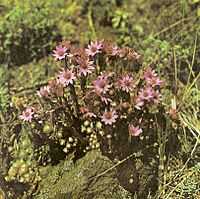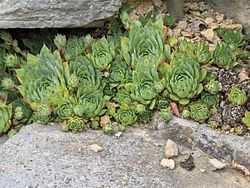Sempervivum
| Sempervivum | |
|---|---|
 | |
| Flowering Sempervivum tectorum | |
| Scientific classification | |
| Kingdom: | Plantae |
| (unranked): | Angiosperms |
| (unranked): | Eudicots |
| (unranked): | Core eudicots |
| Order: | Saxifragales |
| Family: | Crassulaceae |
| Genus: | Sempervivum L. |
| Species | |
|
Sempervivum altum | |
Sempervivum /sɛmpəˈvaɪvəm/,[1] is a genus of about 40 species of flowering plants in the Crassulaceae family, known as houseleeks. Other common names include liveforever and hen and chicks. They are succulent perennials forming mats composed of tufted leaves in rosettes. In favourable conditions they spread rapidly via offsets, and several species are valued in cultivation as groundcover for dry, sunny spots.[2]
Habitat
Houseleeks occur from Morocco to Iran, through the mountains of Iberia, the Alps, Carpathians, Balkan mountains, Turkey, the Armenian mountains, in the northeastern part of the Sahara Desert, and the Caucasus. Their ability to store water in their thick leaves allows them to live on sunny rocks and stony places in the mountain, subalpine and alpine belts.
Subtropical origin

Like some other plants of Southern Europe, the ancestors of houseleeks are likely to have a subtropical origin. Morphologically, they are closely linked with the genera Jovibarba, Aeonium, Greenovia, Aichryson, and Monanthes, occurring mainly in Macaronesia (Azores, Canary Islands, Cape Verde, Madeira). Some botanists include some or all of these genera within a wider interpretation of Sempervivum, particularly Jovibarba.
Origin of name
The name Sempervivum has its origin in the Latin semper ("always") and vivus ("living"), because this perennial plant keeps its leaves in winter and is very resistant to difficult conditions of growth.[3] The common name houseleek is believed to stem from the traditional practice of growing plants on the roofs of houses to ward off lightning strikes.[3] The plant is not closely related to the true leek, which belongs to the onion family.
Other common names reflect the plant's ancient association with Thor, the Norse god of thunder, and the Roman Jupiter. Hence names such as "Jupiter's beard" and the German Donnersbart ("thunder beard").[3]
Growth and reproduction
Houseleeks grow as tufts of perennial but monocarpic rosettes. Each rosette propagates asexually by lateral rosettes (offsets, "hen and chicks"), by splitting of the rosette (only Jovibarba heuffelii) or sexually by tiny seeds.

Identification
The genus Sempervivum is easy to recognize, but its species are often not easy to identify. Even one single clone can look very different under various growth conditions (modifications) or different times of the year. The members of this genus are very similar and closely linked to each other. As a consequence, many subspecies, varieties, and forms were described, without well-defined limits between them. As a second consequence, there is a high frequency of natural hybrids in this genus and the possibility of back-crossings of these. However, more or less 40 species can be individualized in the whole area of the genus, but there are many more local populations, without nomenclatural valour but sometimes with their own characters.
In the Alps, for example, the most distributed species are Sempervivum tectorum (common houseleek, sometimes called Sempervivum alpinum), Sempervivum montanum (mountain houseleek) and Sempervivum arachnoideum (cobwebbed houseleek), each one with several subspecies. More local are the yellow-flowered S. wulfenii and S. grandiflorum, and the beautiful limestone houseleek (S. calcareum). More rare are S. dolomiticum and mainly S. pittonii. S. pittonii is a small yellow-flowered jewel growing only on two mountains slopes near Kraubath in the Mur valley in Austria and is very threatened.[citation needed]
On roofs or old walls S. tectorum can be found, more or less wild, very far out of its natural area. It is a very old medicinal and witch-plant. Some superstitious people believe this plant is able to protect a house from lightning.[citation needed]
Garden and container plants
Although their subtropical cousins are very frost-sensitive, sempervivums are among the most frost-resistant succulents, making them popular garden plants. They tend to grow best in dry conditions with well-draining, sandy soil to prevent soggy roots. They require only moderate watering, especially during warmer months, with occasional protection from extreme sun exposure.
Sempervivums also make suitable plants for containers, and do well in breathable terracotta, concrete, and cement pots. They have also been known to grow in rock crevices, metal containers, succulent wreaths, roof shingles, and anywhere else that allows adequate root drainage.
"Semp-lovers" are numerous and often have many different cultivars in their collections. Sempervivums are very variable plants and hence hundreds, maybe thousands of cultivars have been created, but a lot of them are not much different from each other. The main interest of these cultivars is not their flowers, but form and color of the rosette-leaves. The most colorful time is generally from March till June.
-
A selection of sempervivum cultivars, for sale at Gardeners' World Live 2012
-
.jpg)
A personal collection of potted sempervivums
-
.jpg)
Sempervivum Pittoni
-

Sempervivum tectorum on a roof
References
External links
| Wikimedia Commons has media related to Sempervivum. |

